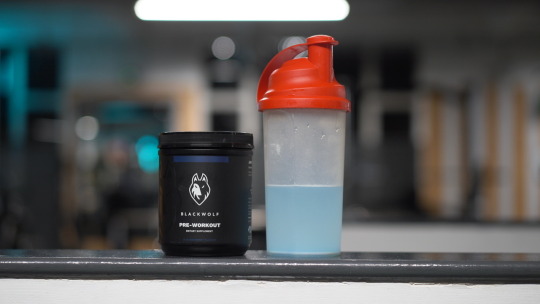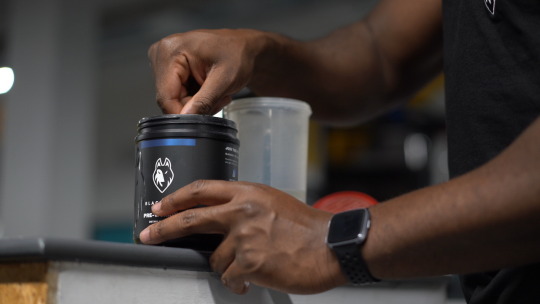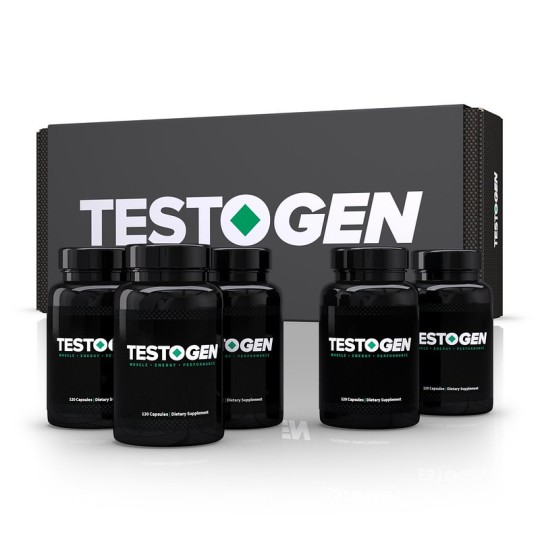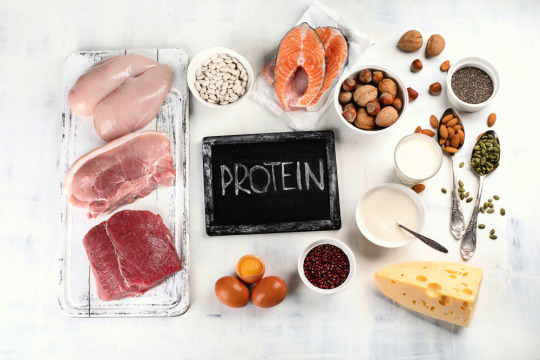Text
How to Lean Bulk Without Getting Fat | Beginner's Guide

Learn how to achieve a lean bulk without gaining fat with our beginner's guide.
Discover tips for optimizing your diet, and exercise routine, and monitoring progress to achieve your fitness goals.
Follow these simple steps to get started on your lean bulking journey today!
First of all this guide is effective and achievable but it can require you a lot of time and patience.
So if you are tired of slow progress on your lean bulking journey?
It's time to take your efforts to the next level with our supplement.
Our specially formulated supplement is designed to support lean muscle growth and minimize excess fat gain, helping you achieve your goals in just 3 months.
CLICK HERE to check it out and get your results faster.
Can You Lean Bulk Without Gaining Fat?
It is possible to grow muscle without gaining fat, but it is difficult and involves a mix of factors, including a properly planned diet and exercise schedule.
To get a lean bulk, you must consume enough calories to support muscle building while limiting excess fat gain.
Consuming a slight surplus of calories, such as 200-500 calories per day, while also ensuring that the majority of those calories come from nutrient-dense foods such as lean proteins, complex carbs, and healthy fats, is usual.
A lean bulk requires a consistent strength training program that targets major muscle groups, in addition to a well-planned diet.
Compound lifts like squats, deadlifts, and bench presses are examples of workouts meant to encourage muscle growth.
It's crucial to note that everyone's body reacts differently to training and diet, so finding the appropriate method for you may need some trial and error.
Furthermore, because gaining lean muscle mass requires time and effort, you must be patient and consistent with your efforts.
How Can I Bulk And Not Gain Belly Fat?
Bulking without adding belly fat is difficult, but it is workable with the appropriate method.
Here are some important tips to help you build muscle without accumulating belly fat:
Consume a moderate calorie surplus: To gain muscle, you must consume more calories than you burn, but not extremely so. Aim for a 200-500 calorie surplus per day so you can promote muscle building without getting too much fat.
Focus on nutrient-dense foods: Consume nutrient-dense foods such as lean proteins, complex carbs, and healthy fats to promote muscle growth while decreasing fat gain. Stay away from processed and high-sugar foods, which are linked to weight gain.
Cardiovascular activity can help you burn excess calories and maintain an ideal shape. To support fat loss when bulking, aim for 2-3 sessions of moderate-intensity exercise per week.
Lift weights: Resistance training is important for gaining muscle mass while bulking. Focus on compound exercises that target various muscle groups and increase muscle growth, such as squats, deadlifts, and bench presses.
Can You Lean Bulk While Being Fat?
It is achievable to lean bulk while overweight or with a greater body fat percentage, but it is more difficult than lean bulking with a lower body fat %.
When you are overweight, your body contains more fat, which shows you are already in a calorie surplus.
If you want to lean bulk even with being overweight, you must be careful not to overeat since this might lead to more fat gain.
How Many Extra Calories For A Lean Bulk?
The number of extra calories required for a lean bulk varies depending on age, gender, weight, height, and activity level.
A calorie extra of 200-500 calories per day is generally recommended as a general guideline for lean bulking.
This small calorie surplus gives enough extra energy to sustain muscle building while reducing the risk of developing too much fat.
However, the calorie excess must be adjusted based on individual demands and progress.
If you're not getting the results you want, try increasing your calorie intake slightly or changing your exercise program.
It's also necessary to keep track of your progress by checking your body composition regularly and changing your food and exercise program as appropriate.
This will help guarantee that you grow muscle without developing too much fat.
Remember that being patient and persistent with your efforts is the key to a successful lean bulk.
Building lean muscle mass requires time and effort, so stick to your goals and make adjustments as needed along the way.
How Long Should A Bulk Last?
Individual desires and personal preferences can influence the length of a mass.
A bulk can last anywhere from 3-6 months, while some people prefer to bulk for a shorter or longer time.
Individual goals and progress should be used to decide the length of a bulk.
If you're seeking to gain muscle mass, you should keep bulking until you reach your ideal amount of muscle mass.
If you're trying to lose excess fat, you might wish to stop bulking after a few months.
It's also essential to track your progress regularly by checking your body composition and enhancing your food and exercise program as necessary.
If you're getting too much fat or not seeing the desired muscle growth, you might need to change your diet or workout program.
Remember that being flexible and consistent with your efforts is the key to a successful lean bulk.
Building muscle mass requires time and work, and it's vital to stick to your goals and make changes along the way.
Conclusion
With the right approach, it is easy to develop lean mass without gaining fat.
You can grow muscle mass while reducing extra fat gain by consuming a little calorie surplus, focusing on nutrient-dense foods, and doing both resistance and cardiovascular training.
To maintain healthy body composition, it's necessary to track your progress regularly and change your food and exercise program as needed.
You may reach your fitness objectives and enjoy the benefits of a lean, strong physique with focus and consistency.
Remember to be patient and have faith in the process, as gaining lean muscle mass takes time and effort.
#fitness#health & fitness#fitness tips#bulking#lean bulk#build muscle#muscle building#building muscles#building muscle#how to build muscle fast
1 note
·
View note
Text
Blackwolf Pre-Workout Review: The All-in-One Supplement for Fitness Enthusiasts

The pre-workout supplement that I use is Blackwolf by MuscleClub Limited.
This product is one of the best on the market today and has helped me get results faster than any other supplement I've tried in the past.
It's made with natural ingredients, which is important to me because I don't want to put anything unnatural into my body when exercising.
The key ingredient in Blackwolf is Beta-Alanine, which helps delay fatigue while working out so you can push yourself harder for longer periods than ever before!
Blackwolf Is A Pre-Workout Supplement Produced By MuscleClub Limited.
Blackwolf is a pre-workout powder produced by MuscleClub Limited.
MuscleClub Limited is a well-known brand in the supplement industry and has been around for some time now, so it's not surprising that they would come up with something like Blackwolf.
This product comes in several flavors including green apple, blue raspberry, and fruit punch.
The Product Comes In Powder Form And Is Meant To Be Mixed With Water.
Blackwolf is a product that comes in powder form and is meant to be mixed with water.
You can also mix it with juice, milk, or other beverages if you prefer.
The Goal Of Taking This Supplement Is To Increase Performance In The Gym.
The goal of taking this supplement is to increase performance in the gym.
It does so by improving energy and focus, increasing strength and endurance, increasing muscle growth, and improving recovery time.
CLICK HERE to check the Blackwolf prices and flavors.
It Is Designed To Help Push Your Body Past The Point Of Failure And Build Lean Muscle Mass.
Blackwolf Pre Workout is designed to help push your body past the point of failure and build lean muscle mass.
The product contains ingredients that are known for their ability to increase strength, endurance, and recovery time after exercise.
It is made with a proprietary blend of ingredients which include caffeine anhydrous (200mg), coconut water powder (300mg), beta-alanine (3200mg), betaine anhydrous (2000mg), and L-arginine alpha-ketoglutarate (1000mg).
There Are Many Positive Reviews From People Who Have Used This Product And Found Success With It.

There are many positive reviews from people who have used this product and found success with it.
Customers who have used Blackwolf Pre Workout have reported feeling stronger and more energized when they work out, as well as being able to lift heavier weights during their workouts.
The majority of users claim that this pre-workout supplement helps them feel less sore after a workout, which is a very important benefit for anyone looking to get into shape or build muscle mass.
Customers who have used Blackwolf have reported being able to lift weights for longer periods and feeling stronger than ever before during their workouts.
They also say that they have more energy and focus. This is due to the high levels of caffeine in this product, which can help you do your best at work or school as well as during exercise!
If You're Looking For A Pre-Workout That Helps Get You Motivated And Ready For Your Workout Then Look No Further Than This One!
Blackwolf Pre Workout has been a favorite among bodybuilders and athletes for many years, but it's still relatively new to the mainstream market.
That means there are plenty of positive reviews out there on sites like Reddit and Amazon.
There are more than 100 reviews on Amazon alone with an average rating of 4 stars out of 5!
If you've been searching around trying to find something else that works as well as Blackwolf but doesn't cost $44.99 per bottle (just kidding), then stop right now because what we have here today is going straight into your cart with free shipping included.*
Conclusion
If you're looking for a pre-workout that helps get you motivated and ready for your workout then look no further than this one!
#preworkout#pre workout supplement#pre workout#health & fitness#fitness#fitness supplements#product reviews
0 notes
Text
The Ultimate Guide to Push Ups: Which Muscles Do They Work?

Push ups are a classic exercise that has been around for decades, and for a good reason.
They are a great way to build strength, muscle, and endurance in the upper body, and can be done anywhere without any equipment.
But which muscles do push ups work?
In this article, we’ll explore the key muscles targeted by push ups, how to perform them correctly, and some variations to make them even more challenging.
Muscles Worked by Push Ups:
1. Chest
The primary muscle group targeted by push ups is the chest.
The pectoralis major and minor muscles are responsible for pushing movements and are essential for upper body strength.
When you perform a push up, your chest muscles contract to push your body away from the ground.
2. Shoulders
Push ups also work the muscles of the shoulders, specifically the deltoids.
The deltoids are responsible for raising your arms and rotating your shoulders.
During push ups, the anterior, middle, and posterior fibers of the deltoids are all activated to help stabilize and control the movement of the shoulder joint.
3. Triceps
The triceps are the muscles located at the back of the upper arm and are responsible for extending the elbow.
They are activated during push ups to help stabilize and extend the arms.
When you lower yourself toward the ground, your triceps work to control the movement and prevent your elbows from flaring out to the sides.
4. Abs
Push ups also engage the core muscles, specifically the rectus abdominis and transverse abdominis.
These muscles help stabilize the body and maintain proper form during the exercise.
To engage your abs during push ups, focus on keeping your body in a straight line from head to heels and engaging your core muscles throughout the movement.
5. Back
The muscles of the back, specifically the erector spinae and latissimus dorsi, are also engaged during push ups.
These muscles help maintain proper posture and stability during the exercise.
When you perform a push up, your back muscles contract to keep your body in a straight line and prevent your hips from sagging or lifting too high.
How to Perform Push Ups Correctly?
To perform push ups correctly and engage all the targeted muscles, follow these steps:
Start in a plank position with your hands shoulder-width apart and your feet together.
Lower your body towards the ground while keeping your core engaged and your elbows close to your body.
Pause when your chest is a few inches from the ground.
Push your body back up to the starting position while keeping your core engaged and your elbows close to your body.
Repeat for the desired number of reps.
Dos and Don’ts of Push Ups:
To get the most out of your push ups and avoid injury, follow these dos and don’ts:
Dos:
Keep your body in a straight line from head to heels.
Keep your core engaged throughout the exercise.
Keep your elbows close to your body.
Breathe in as you lower your body and breathe out as you push back up.
Don’ts:
Let your hips sag or lift too high.
Allow your elbows to flare out to the sides.
Hold your breath during the exercise.
Rush through the exercise or sacrifice form for speed.
Variations of Push Ups:
Once you have mastered the basic push up, you can make them more challenging and target different muscle groups with variations.
Here are a few examples:

1. Diamond Push Ups
Diamond push ups are a variation that targets the triceps more intensely than regular push ups.
To perform a diamond push up, place your hands close together in a diamond shape under your chest, with your thumbs and index fingers touching.

2. Wide Grip Push Ups
Wide grip push ups target the chest and outer shoulders more intensely than regular push ups.
To perform a wide grip push up, place your hands wider than shoulder-width apart.

3. Incline Push Ups
Incline push ups are a beginner-friendly variation that is easier to perform than regular push ups.
To perform an incline push up, place your hands on a raised surface such as a bench or step.

4. Decline Push Ups
Decline push ups are a more advanced variation that targets the upper chest more intensely than regular push ups.
To perform a decline push up, place your feet on a raised surface such as a bench or step.
Conclusion
By incorporating push ups into your workout routine and targeting the key muscles of the chest, shoulders, triceps, abs, and back, you can build strength, muscle, and endurance in your upper body.
With proper form, consistency, and progression, push ups can help you achieve your fitness goals and improve your overall health and well-being.
Subscribe to THIS LINK if you want to receive daily fitness tips and valuable information every day.
#health & fitness#fitness#workout#exercise#gym life#working out#workout tips#fitness tips#pushups#push ups#push up bra#push up challenge#muscles#muscle#muscle building
2 notes
·
View notes
Text
The Dos and Don'ts of a Calorie Deficit Diet for Fat Loss

A calorie deficit diet is an effective way to lose fat, but it's important to do it right. In this article, we'll explore the dos and don'ts of a calorie deficit diet for fat loss.
Fat loss is a common goal for many people, but it can be challenging to achieve.
One of the most effective ways to lose fat is through a calorie deficit diet, which means consuming fewer calories than your body burns.
However, it's important to do it right and avoid common mistakes that can hinder your progress.
In this article, we'll explore the dos and don'ts of a calorie deficit diet for fat loss.
Dos:
1. Calculate Your Caloric Needs
To create a calorie deficit diet, you need to know how many calories your body needs.
You can use online calculators to estimate your daily caloric needs based on your age, gender, weight, height, and activity level.
Once you have this number, you can create a calorie deficit by reducing your daily caloric intake by 500-1000 calories.
2. Choose Nutrient-Dense Foods
When you're in a calorie deficit, it's important to choose foods that are nutrient-dense to ensure you're getting all the essential vitamins and minerals your body needs.
Focus on whole foods such as fruits, vegetables, lean proteins, and complex carbohydrates.
These foods are not only nutrient-dense but also low in calories, making them ideal for a calorie deficit diet.
3. Monitor Your Progress
Tracking your progress is essential when you're on a calorie deficit diet.
Use a food diary or a tracking app to monitor your daily caloric intake and ensure you're staying within your target range
You can also use a scale or take measurements to track your progress over time.
4. Stay Hydrated
Drinking plenty of water is essential when you're on a calorie deficit diet.
Water can help you feel full and reduce your appetite, making it easier to stick to your calorie deficit.
Aim for at least 8 glasses of water per day, and avoid sugary drinks that can add unnecessary calories to your diet.
Don'ts:
1. Cut Calories Too Quickly
While reducing your daily caloric intake is essential for a calorie deficit diet, cutting calories too quickly can be counterproductive.
Your body needs time to adjust to the new calorie intake, and cutting too many calories too quickly can lead to fatigue, muscle loss, and a slower metabolism
Aim to reduce your daily caloric intake by no more than 500-1000 calories per day to ensure sustainable and healthy weight loss.
2. Restrict Entire Food Groups
Restricting entire food groups such as carbohydrates or fats can also be counterproductive.
Your body needs a balanced diet to function properly, and restricting certain food groups can lead to nutrient deficiencies and other health problems.
Instead, focus on choosing nutrient-dense foods from all food groups and aim to balance your macronutrient intake (carbohydrates, fats, and proteins).
3. Rely Solely on Cardio
While cardio is an important part of any fitness routine, relying solely on cardio for fat loss can be a mistake.
Strength training is also essential for maintaining muscle mass and boosting your metabolism, which can help you burn more calories at rest.
Aim to include both cardio and strength training in your fitness routine for optimal fat loss.
4. Skip Meals
Skipping meals may seem like a good way to reduce your daily caloric intake, but it can be more harmful than good.
Skipping meals can lead to overeating later in the day and can also slow down your metabolism, making it harder to lose fat.
Instead, aim to eat smaller, more frequent meals throughout the day to keep your metabolism revved up and your hunger in check.
Conclusion
A calorie deficit diet is a highly effective way to lose fat, but it's important to do it right.
By following the dos and don'ts outlined in this article, you can ensure sustainable and healthy weight loss.
Remember to focus on nutrient-dense foods, monitor your progress, and stay hydrated.
Avoid cutting calories too quickly, restricting entire food groups, relying solely on cardio, and skipping meals.
With a little patience and consistency, you can achieve your fat loss goals and enjoy a healthier, happier life.
And if you want to speed up your fat loss journey and reach your goals faster then you need this Click Here to check it out.
#fitness#health & fitness#health and wellness#health#best way to lose weight#fat loss#lose fat#calories#calorie deficit for weight loss#calorie deficit diet#losing weight#weight loss diet#lose weight#weight loss
1 note
·
View note
Text
Testogen Ingredients: The Safe and Effective Way to Increase Testosterone Levels

In this article, we'll explore the key Testogen ingredients and how they work together to increase testosterone levels safely and effectively.
Testosterone is a critical hormone for male health and vitality, but as men age, their testosterone levels naturally decline.
Fortunately, there are natural ways to boost testosterone levels, and one of the most effective ways is through the use of Testogen, a natural testosterone booster that contains a potent blend of ingredients.
Key Ingredients of Testogen:
1. D-Aspartic Acid: Stimulates Testosterone Production
D-Aspartic Acid (DAA) is an amino acid that plays a critical role in the production of testosterone.
It works by stimulating the release of luteinizing hormone (LH), which signals the testes to produce more testosterone.
Studies have shown that DAA can increase testosterone levels by up to 42% in just 12 days, making it a powerful ingredient in Testogen.
2. Magnesium: Reduces SHBG Levels
Magnesium is an essential mineral that is involved in many bodily functions, including muscle and nerve function, blood sugar regulation, and bone health.
It also plays a role in testosterone production by binding to sex hormone-binding globulin (SHBG), which can inhibit the production of testosterone.
By reducing SHBG levels, magnesium can help to increase free testosterone levels in the body.
3. Vitamin D3: Stimulates Testosterone Production
Vitamin D3 is a fat-soluble vitamin that is essential for bone health, immune function, and overall health.
It also plays a critical role in testosterone production by stimulating the production of luteinizing hormone (LH).
Studies have shown that men who supplement with vitamin D3 have higher testosterone levels than those who don't.
4. Zinc: Stimulates Testosterone Production
Zinc is an essential mineral that is involved in many bodily functions, including immune function, wound healing, and cell growth and division.
It also plays a crucial role in testosterone production by stimulating the production of luteinizing hormone (LH).
Studies have shown that zinc can increase testosterone levels in men with low levels of zinc.
5. Vitamin K1: Reduces SHBG Levels
Vitamin K1 is a fat-soluble vitamin that reduces SHBG levels, leading to higher free testosterone levels in the body.
6. Nettle Leaf Extract: Increases Free Testosterone Levels
Nettle leaf extract binds to SHBG, reducing its ability to bind to testosterone and increasing free testosterone levels in the body.
7. Korean Red Ginseng Extract: Stimulates Testosterone Production
Korean red ginseng extract is a traditional herbal remedy that has been used for centuries to improve vitality and overall health.
It also plays a role in testosterone production by stimulating the release of luteinizing hormone (LH).
Studies have shown that Korean red ginseng extract can increase testosterone levels in men.
8. Fenugreek Extract: Inhibits Estrogen Production
Fenugreek extract is a natural ingredient that has been shown to improve testosterone levels and sexual function in men.
It works by inhibiting the activity of enzymes that convert testosterone into estrogen, leading to higher testosterone levels in the body.
9. Boron: Reduces SHBG Levels
Boron is a trace mineral that reduces SHBG levels, leading to higher free testosterone levels in the body.
10. Bioperine: Enhances Nutrient Absorption
Bioperine improves the absorption of other nutrients in the body, including the ingredients in Testogen.
In Conclusion
Testogen is a natural testosterone booster that contains a powerful blend of ingredients designed to increase testosterone levels safely and effectively.
By incorporating these ingredients into your supplement regimen, you can support testosterone production, improve muscle mass, and enhance overall vitality and health.
Always consult with your healthcare provider before starting any new supplement regimen to ensure it's safe for you.
#health & fitness#fitness#men's health#health and wellness#health#testosterone#how to increase testosterone#testosterone booster#testosterone positivity#male#product recommendations#product reviews
1 note
·
View note
Text
Protein Intake for Building Muscle: How Much is Enough?

Protein is essential for muscle growth and repair, making it a key nutrient for anyone looking to build muscle.
But how much protein do you need to consume to see results?
In this article, we'll discuss the importance of protein intake for building muscle, how much protein you need, and the best sources of protein to maximize your gains.
The Importance of Protein for Building Muscle.

Protein is made up of amino acids, which are the building blocks of muscle tissue.
When you exercise, you create tiny tears in your muscles that need to be repaired and rebuilt.
Consuming enough protein provides your body with the amino acids it needs to repair and rebuild muscle tissue, leading to muscle growth over time.
Protein Intake for Preserving Muscle Mass.

In addition to its role in muscle growth and repair, protein helps preserve muscle mass when you're in a calorie deficit.
When you're trying to lose weight or body fat, you need to be in a calorie deficit, which means you're consuming fewer calories than you're burning.
This can lead to muscle loss if you're not consuming enough protein, making it harder to maintain your muscle mass and achieve your desired physique.
How Much Protein Do You Need?

So, how much protein do you need to consume to build muscle?
The answer depends on several factors, including your weight, body composition, and activity level.
A general rule of thumb is to consume at least 1 gram of protein per pound of body weight per day.
For example, if you weigh 150 pounds, you should aim to consume at least 150 grams of protein per day.
However, this recommendation may vary depending on your individual needs.
Protein Intake for Athletes and Highly Active Individuals.

If you're an athlete or highly active, you may need to consume more protein to support your muscle growth and recovery.
Research suggests that consuming up to 1.6 grams of protein per pound of body weight per day may be beneficial for athletes and highly active individuals.
The Importance of Evenly Distributing Protein Intake.

It's also important to distribute your protein intake evenly throughout the day, rather than consuming most of your protein in one or two meals.
Consuming protein throughout the day helps to stimulate muscle protein synthesis, leading to greater muscle growth and recovery.
Choosing High-Quality Protein Sources.

When it comes to protein intake for building muscle, not all protein sources are created equal.
Some protein sources, such as red meat and processed meats, may increase the risk of chronic diseases like cancer and heart disease when consumed in large amounts.
To maximize your gains, focus on consuming high-quality protein sources that are rich in essential amino acids.
Examples of High-Quality Protein Sources.
Some examples of high-quality protein sources include:
Lean meats like chicken, turkey, and fish
Eggs and egg whites
Dairy products like milk, cheese, and Greek yogurt
Plant-based sources like beans, lentils, and soy products
Conclusion
In summary, if you want to build muscle, you need to prioritize your protein intake.
Protein is essential for muscle growth and repair, and you should aim to consume at least 1 gram of protein per pound of body weight per day.
Choose high-quality protein sources and distribute your protein intake evenly throughout the day to maximize your gains.
Remember, building muscle takes time and dedication.
Prioritizing your protein intake, choosing high-quality protein sources, and distributing your protein intake evenly throughout the day can help you achieve your muscle-building goals.
By following these guidelines and staying consistent with your nutrition and exercise routine, you can support your muscle growth and achieve your desired physique.
#fitness#health#health & fitness#nutrition#protein#healthy#healthy food#muscle#muscles#protein intake#building muscle#muscle building#build muscle#building muscles
0 notes
Text
5 Proven Techniques for Boosting Testosterone Levels Quickly

As men age, their testosterone levels naturally decline, leading to a range of health problems like decreased muscle mass, low energy levels, and decreased libido.
If you’re looking for ways to increase your testosterone levels quickly and naturally, here are five proven techniques to try:
1. Exercise Regularly

Regular exercise can help boost your testosterone levels naturally.
Weightlifting and high-intensity interval training (HIIT) are particularly effective at increasing testosterone levels.
Aim for at least 30 minutes of exercise per day to see the best results.
When you exercise, your body releases hormones like testosterone and growth hormone.
These hormones help build muscle mass and strength, increase bone density, and boost overall energy levels.
Weightlifting and HIIT are particularly effective at increasing testosterone levels, as they challenge your muscles and stimulate the release of testosterone in response.
To get the most benefit from your exercise routine, aim for at least 30 minutes of exercise per day.
This can include weightlifting, HIIT, cardio, or any other type of physical activity that you enjoy.
Over time, you’ll notice an increase in your energy levels, muscle mass, and overall health.
2. Get Enough Sleep

Lack of sleep can lead to a decrease in testosterone levels.
Aim for 7–8 hours of sleep per night to ensure your body has enough time to rest and recover.
Sleep is essential for optimal health and vitality.
When you sleep, your body releases hormones like testosterone and growth hormone that help repair and rebuild your muscles, bones, and other tissues.
If you don’t get enough sleep, your body may not produce enough of these hormones, leading to a decrease in testosterone levels over time.
To ensure you get enough sleep, aim for 7–8 hours of sleep per night.
This will give your body enough time to rest, and recover and help ensure that your testosterone levels stay in a healthy range.
3. Eat A Healthy Diet

A balanced diet that includes plenty of protein, healthy fats, and fresh fruits and vegetables can help boost testosterone levels.
Zinc-rich foods like oysters, beef, and spinach are particularly effective at increasing testosterone levels.
Your diet plays a crucial role in your overall health and vitality.
To increase your testosterone levels quickly and naturally, focus on eating a balanced diet that includes plenty of protein, healthy fats, and fresh fruits and vegetables.
These foods provide your body with the nutrients it needs to build muscle mass, increase bone density, and produce healthy levels of testosterone.
In addition, zinc-rich foods like oysters, beef, and spinach are particularly effective at increasing testosterone levels.
Zinc is a mineral that is essential for testosterone production, and eating foods that are rich in zinc can help ensure that your body has enough of this important nutrient.
4. Manage Stress

Chronic stress can lead to a decrease in testosterone levels.
Try to manage stress through techniques like meditation, yoga, or deep breathing exercises.
Stress is a common problem in today’s fast-paced world.
When you’re stressed, your body produces hormones like cortisol that can interfere with testosterone production and lead to a decrease in testosterone levels over time.
To manage stress, try incorporating techniques like meditation, yoga, or deep breathing exercises into your daily routine.
These techniques can help calm your mind and reduce stress levels, allowing your body to produce healthy levels of testosterone.
5. Take A Natural Testosterone Booster Supplement

Natural testosterone booster supplements can help increase testosterone levels quickly and effectively.
Look for supplements that contain natural ingredients like ashwagandha, fenugreek, and D-aspartic acid.
If you’re looking for a fast and effective way to increase your testosterone levels, taking a natural testosterone booster supplement is your best bet.
These supplements are designed to help boost your testosterone levels quickly and naturally, without the need for prescription medications or invasive procedures.
When choosing a testosterone booster supplement, look for products that contain natural ingredients like ashwagandha, fenugreek, and D-aspartic acid.
These ingredients have been shown to increase testosterone levels quickly and effectively, without any harmful side effects.
HERE IS your best choice when choosing a natural testosterone booster supplement.
In addition to taking a natural testosterone booster supplement, it’s important to incorporate the other four techniques into your daily routine to ensure the best results.
In Conclusion
Incorporating these five proven techniques into your daily routine can help increase your testosterone levels quickly and naturally.
By exercising regularly, getting enough sleep, eating a healthy diet, managing stress, and taking a natural testosterone booster supplement, you can enjoy a range of health benefits, including increased energy levels
#fitness#health#health & fitness#health and wellness#testosterone#jacked#roid#male#men's health#masculine#muscular#muscle#how to increase testosterone
2 notes
·
View notes